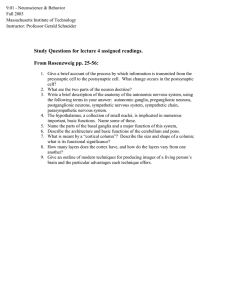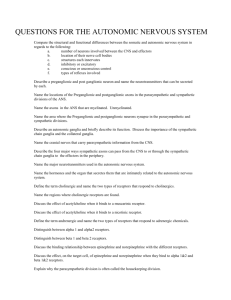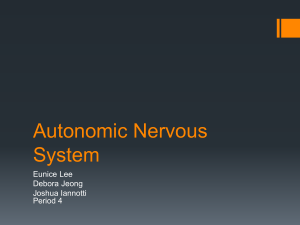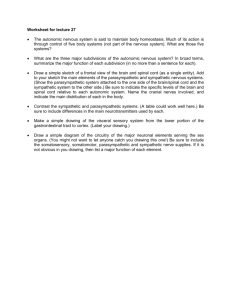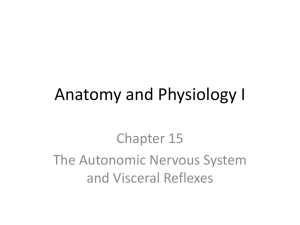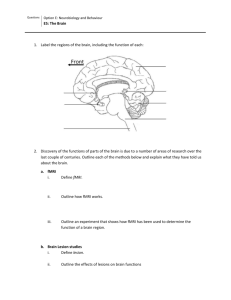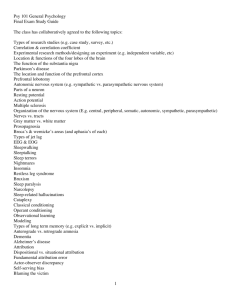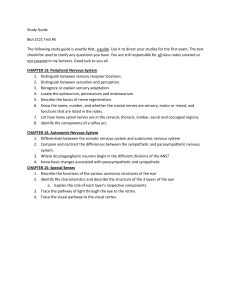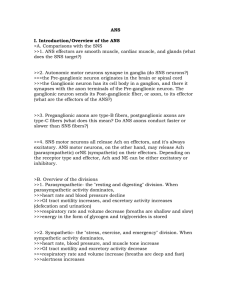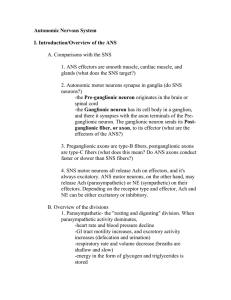Autonomic Nervous System Chapters 14
advertisement
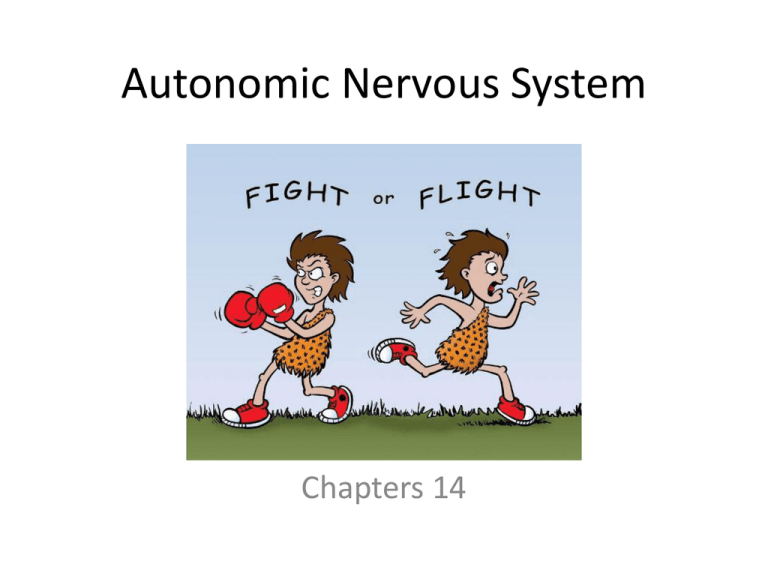
Autonomic Nervous System Chapters 14 Autonomic Nervous System (ANS) • The ANS consists of motor neurons that: – Innervate smooth and cardiac muscle and glands – Make adjustments to ensure optimal support for body activities – Operate via subconscious control Somatic & Autonomic Nervous Systems • The two systems differ in: – Effectors – Efferent pathways & ganglia – Target organ responses to neurotransmitters Effectors Somatic Nervous System Autonomic Nervous System • Effectors • Effectors – Skeletal muscle • Efferent Pathway – A thick, heavily myelinated somatic motor fiber makes up each pathway from the CNS to the muscle – Cardiac muscle – Smooth muscle – Glands • Efferent Pathway – Preganglionic neuron (in CNS) has a thin, lightly myelinated preganglionic axon – (Post) Ganglionic neuron in autonomic ganglion has an unmyelinated postganglionic axon that extends to the effector organ Neurotransmitter Effects • Somatic nervous system – All somatic motor neurons release acetylcholine (ACh) – Effects are always stimulatory • Autonomic Nervous System – Preganglionic fibers release ACh – Postganglionic fibers release norepinephrine or ACh at effectors – Effect is either stimulatory or inhibitory, depending on type of receptors SOMATIC NERVOUS SYSTEM Cell bodies in central nervous system Peripheral nervous system Neurotransmitter at effector Effector organs Single neuron from CNS to effector organs Effect + ACh Stimulatory Heavily myelinated axon Skeletal muscle NE SYMPATHETIC ACh Unmyelinated postganglionic axon Lightly myelinated Ganglion Epinephrine and preganglionic axons norepinephrine ACh Adrenal medulla PARASYMPATHETIC AUTONOMIC NERVOUS SYSTEM Two-neuron chain from CNS to effector organs Acetylcholine (ACh) Blood vessel ACh ACh Lightly myelinated preganglionic axon Ganglion + Unmyelinated postganglionic axon Smooth muscle (e.g., in gut), glands, cardiac muscle Stimulatory or inhibitory, depending on neurotransmitter and receptors on effector organs Norepinephrine (NE) Figure 14.2 Divisions of the ANS 1.Sympathetic division 2.Parasympathetic division Dual innervation –Almost all visceral organs are served by both divisions, but they cause opposite effects Role: Parasympathetic Division • Promotes maintenance activities and conserves body energy • Illustration: person who relaxes, reading, after a meal – Blood pressure, heart rate, and respiratory rates are low – Gastrointestinal tract activity is high – Pupils are constricted and lenses are accommodated for close vision Role of the Sympathetic Division • Mobilizes the body during activity – “fight-or-flight” system • Promotes adjustments during exercise, or when threatened – Blood flow is shunted to skeletal muscles and heart – Bronchioles dilate – Liver releases glucose ANS Anatomy Division Sympathetic Origin of Fibers Thoracolumbar region of the spinal cord Parasympathetic Brain and sacral spinal cord (craniosacral) Length of Fibers Location of Ganglia Short preganglionic and long postganglionic Close to spinal cord Long preganglionic and short postganglionic In visceral effector organs Parasympathetic Eye Brain stem Salivary glands Heart Sympathetic Eye Skin* Cranial Sympathetic ganglia Salivary glands Cervical Lungs Lungs T1 Heart Stomach Stomach Thoracic Pancreas Liver and gallbladder Pancreas L1 Liver and gallbladder Adrenal gland Lumbar Bladder Bladder Genitals Genitals Sacral Figure 14.3 Pathways w/ Synapses in the Adrenal Medulla • Some preganglionic fibers pass directly to the adrenal medulla without synapsing • Upon stimulation, medullary cells secrete norepinephrine and epinephrine into the blood Neurotransmitters • Cholinergic fibers release the neurotransmitter ACh – All ANS preganglionic axons – All parasympathetic postganglionic axons • Adrenergic fibers release the neurotransmitter NE – Most sympathetic postganglionic axons – Exceptions: sympathetic postganglionic fibers secrete ACh at sweat glands and some blood vessels in skeletal muscles Cholinergic Receptors • Two types of receptors bind ACh 1. Nicotinic 2. Muscarinic Named after drugs that bind to them and mimic ACh effects Cholinergic Receptors: Nicotinic • Found on: – Motor end plates of skeletal muscle cells – All ganglionic neurons (sympathetic and parasympathetic) – Hormone-producing cells of the adrenal medulla • Effect of ACh at nicotinic receptors is always stimulatory Cholinergic Receptors: Muscarinic • Found on – All effector cells stimulated by postganglionic cholinergic fibers (parasympathetic) • The effect of ACh at muscarinic receptors – Can be either inhibitory or excitatory – Depends on the subclass of receptor on the target organ Adrenergic Receptors • Two types of receptors bind NE – Alpha () (subtypes 1, 2) – Beta () (subtypes 1, 2 , 3) • Effects of NE depend on which subclass of receptor predominates on the target organ – 3: found in adipose tissue, activation = lipolysis by fat cells. Interactions of the Autonomic Divisions • Most visceral organs have dual innervation • Dynamic antagonism allows for precise control of visceral activity – Sympathetic division increases heart and respiratory rates, and inhibits digestion and elimination – Parasympathetic division decreases heart and respiratory rates, and allows for digestion and the discarding of wastes Sympathetic Tone • Sympathetic division controls blood pressure (even at rest) • Sympathetic tone (vasomotor tone) – Keeps the blood vessels in a continual state of partial constriction • Sympathetic fibers fire more rapidly to constrict blood vessels and cause blood pressure to rise • Sympathetic fibers fire less rapidly to prompt vessels to dilate to decrease blood pressure Parasympathetic Tone • Parasympathetic division normally dominates the heart and smooth muscle of digestive and urinary tract organs – Slows the heart – Dictates normal activity levels of the digestive and urinary tracts • The sympathetic division can override these effects during times of stress Unique Roles of the Sympathetic Division • The adrenal medulla, sweat glands, arrector pili muscles, kidneys, and most blood vessels receive only sympathetic fibers • The sympathetic division controls – Thermoregulatory responses to heat – Release of renin from the kidneys – Metabolic effects • Increases metabolic rates of cells • Raises blood glucose levels • Mobilizes fats for use as fuels Localized Versus Diffuse Effects • Parasympathetic division: short-lived, highly localized control over effectors • Sympathetic division: long-lasting, body-wide effects – because NE: • Is inactivated more slowly than ACh • NE and epinephrine are released into the blood and remain there until destroyed by the liver Control of ANS Functioning • Hypothalamus—main integrative center of ANS activity • Subconscious cerebral input via limbic lobe connections influences hypothalamic function • Other controls come from the cerebral cortex, the reticular formation, and the spinal cord Hypothalamic Control • Control may be direct or indirect (through the reticular system) – Anterior: direct parasympathetic functions – Posterior: direct sympathetic funcitons • Centers of the hypothalamus control – Heart activity and blood pressure – Body temperature, water balance, and endocrine activity – Emotional stages (rage, pleasure) and biological drives (hunger, thirst, sex) – Reactions to fear and the “fight-or-flight” system
